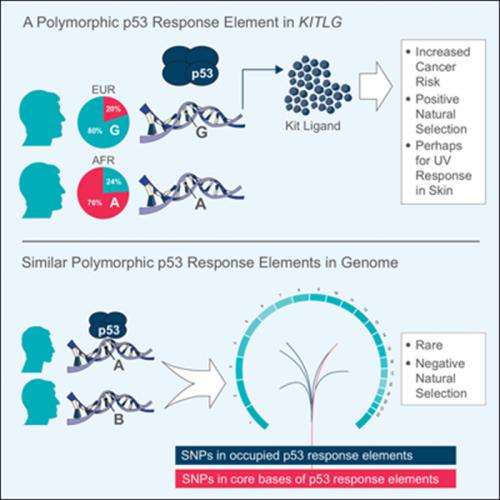A genetic variation that could protect skin from sun damage fuels testicular cancer

A Ludwig Cancer Research study published in Cell today identifies a common mutation that dramatically increases the risk for testicular cancer—and describes a likely molecular mechanism by which it exerts that effect. The researchers also suggest why, despite its potential lethality, the genetic variation has been favored by natural selection to become common in light-skinned people. It appears this mutation might aid the tanning of Caucasian skin in response to sunlight, protecting it from UV radiation, which can burn and cause cancer.
"Knowing the inherited genetics of cancer has great potential in medicine," says co-author Gareth Bond who is a Ludwig researcher at Oxford University. "It can aid the development of tests to predict the risk of developing particular malignancies. It can also tell physicians about the likely prognosis of cancers, and inform therapeutic choices, improving management of the disease."
The DNA sequence of the human genome is peppered with tiny variations that help account for many of the differences between people, from the color of their eyes to the curliness of their hair to their risk of obesity. These mutations, known as single nucleotide polymorphisms (SNPs)—because they change only one base, or "letter", in the sequence—are also associated with risk for a wide variety of diseases, not least cancers. But in most cases, it is unclear how any particular SNP contributes to the risk for developing its associated illness.
The SNP discovered by Bond and co-author Douglas Bell of the US National Institute of Environmental Health Sciences affects the activity of a protein named p53, which is best known as the cell's most important defense mechanism against cancer. In response to various stimuli, p53 binds to a specific pattern of DNA sequences—known as response elements—to turn on a dizzying array of genes that drive everything from embryonic development to the induced suicide of potentially cancerous cells. The team analyzed databases containing 62,567 SNPs associated with cancer, looking for mutations that alter p53's ability to turn on its target genes. They report the detection of one that boosts p53's association with a key response element and show that this particular SNP is very tightly linked to the risk of developing testicular cancer.
The SNP resides in a p53 response element that activates the production of a protein named KIT ligand (KITLG). The study shows that KITLG activation by p53 can fuel the proliferation of cells. Experiments also suggest that the SNP significantly boosts p53's ability to regulate KITLG in a variety of cells. "It appears," Bell explains, "that this particular variant permits testicular stem cells to grow in the presence of DNA damage, when they are supposed to stop growing, since such damage can lead to cancer."
An evolutionary genomic analysis conducted by the team reveals that inherited SNPs that alter p53's ability to bind its response elements have been ruthlessly eliminated by natural selection. Yet their analysis also reveals that their identified SNP (named KITLG p53 RE SNP, rs4590952) has not only slipped through the selective, negative filters of evolution, but has been positively selected in the Caucasian gene pool.
To explain why this SNP might have been positively selected and escaped negative selection, the authors draw from their own and other studies of the skin's response to sunlight. Though UV light can burn and cause cancer, it is also important to human health, necessary for the production of the essential nutrient vitamin D, among other things. To balance the benefits of sunlight against its inherent dangers, the body makes the pigment melanin. The detection of UV damage activates p53 in certain cells of the skin, fueling the secretion of KITLG and prompting pigment-making cells called melanocytes to multiply and ramp up melanin production. The result: a protective tan.
Bell, Bond and their team confirm in their experiments that p53 drives KITLG production and melanocyte proliferation in mice exposed to high levels of UV light. Their genomic analysis shows, notably, that the version of the KITLG p53 response element that responds better to p53 is found in the genomes of 79% of Caucasian Europeans, but only 24% of Africans—who have a four to five-fold lower risk for testicular cancer than do Caucasians.
"Over the course of evolution, as humans migrated out of Africa into the dimly lit terrain of the north, they developed lighter skin, most likely to adapt to the lower levels of sunlight," explains Bond. "Unfortunately, that adaptation also left their skin susceptible to UV damage. It is intriguing to speculate that the better version of the KITLG p53 response element is evolution's compensation for that vulnerability. But it appears to come at a cost—which is a greater risk for testicular cancer."
More information: Cell, Zeron-Medina et al.: "A Polymorphic p53 Response Element in KIT Ligand Influences Cancer Risk and Has Undergone Natural Selection." dx.doi.org/10.1016/j.cell.2013.09.017


















